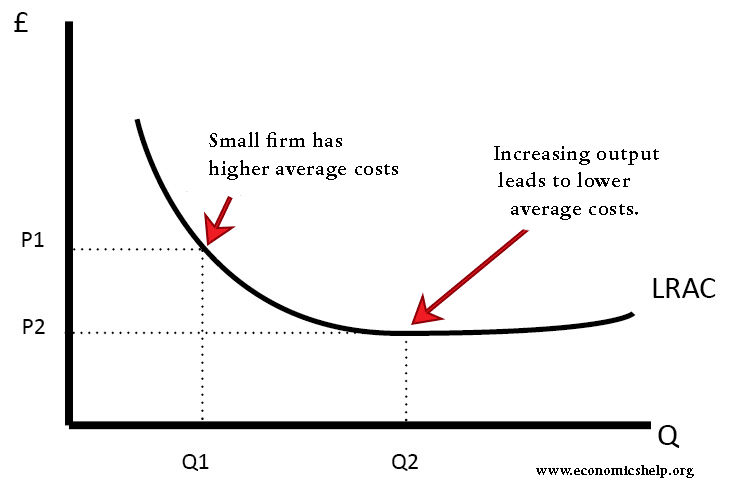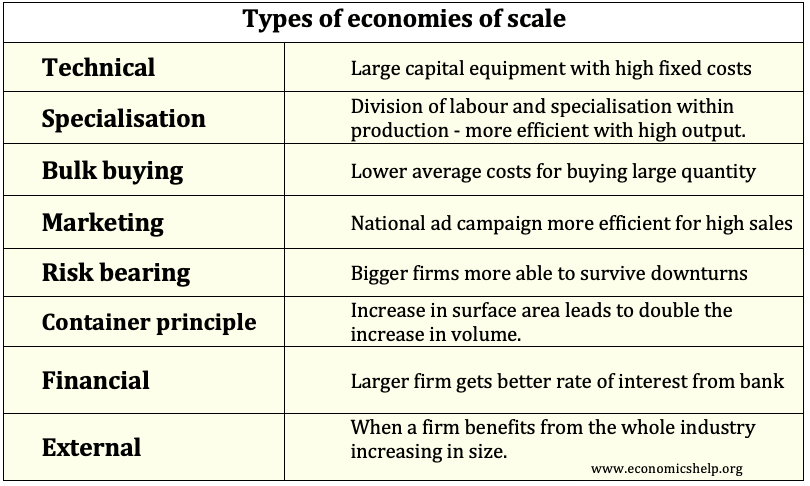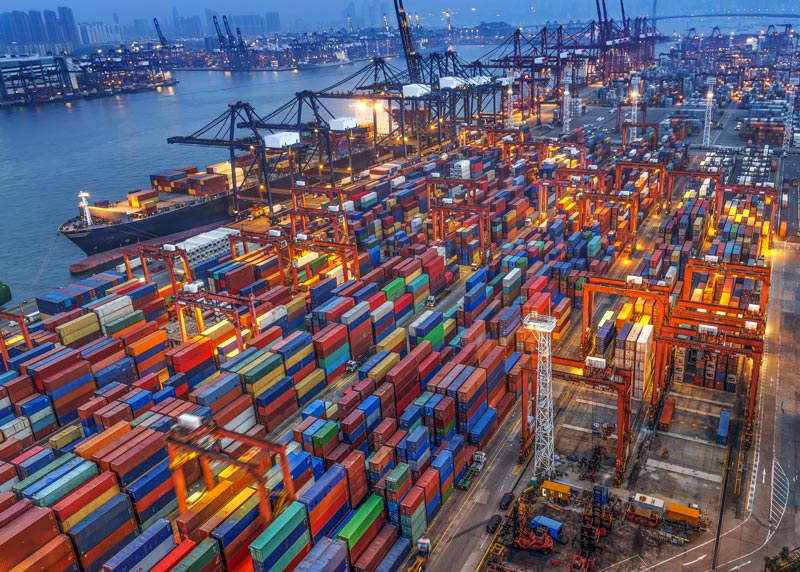Economies of scale occur when increased output leads to lower unit costs. (lower average costs)
Diagram Economies of Scale

This diagram shows that as firms increase output from Q1 to Q2, average costs fall from P1 to P2. There are many different types and examples of how firms can benefit from economies of scale – including specialisation, bulk buying and the use of assembly lines.

Examples of economies of scale include
Tap Water – High fixed costs of a national network
To produce tap water, water companies had to invest in a huge network of water pipes stretching throughout the country. The fixed cost of this investment is very high. However, since they distribute water to over 25 million households, it brings the average cost down. However, would it be worth another water company building another network of water pipes to compete with the existing company? No, because if they only got a small share of the market, the average cost would be very high and they would go out of business. This is an example of a natural monopoly – where the most efficient number of firms is one.
Specialisation – car production

Another economy of scale is in the production of a complex item such as a motor car. The production process involves many different complex stages. Therefore to produce a car you should split up the process and have workers specialise in producing a certain part. e.g. a worker may become highly specialised in the design of a car; another in testing e.t.c. Specialisation requires less training of workers and a more efficient production process. However, if you have several distinct production processes, it is most efficient to have a large output.
Bulk Buying – Supermarkets
Supermarkets can benefit from economies of scale because they can buy food in bulk and get lower average costs. If you had a delivery of just 100 cartons of milk the average cost is quite high. The marginal cost of delivering 10,000 cartons is quite low. You still need to pay only one driver; the fuel costs will be similar. True, you may need a bigger van, but the average cost of transporting 10,000 is going to be a lot less than transporting 100.
Marketing Economies
If you spend £100 on a national tv advertising campaign, it is only worthwhile if you are a big national company like Starbucks or Coca-Cola. If your output is small, the average cost of the advertising is much higher.
Risk Bearing
To develop new drugs to treat illness takes considerable degrees of investment and research with no guarantee of success. Therefore this can only be undertaken by pharmaceutical companies with significant resources. Major pharmaceuticals companies, such as Novartis, Pfizer Inc and GlaxoSmithKline Plc all undertake significant research in developing new drugs.
Container Principle
More efficient transport and packaging with bigger containers. If the surface area of a container increases by 100%, the volume it can carry will increase by 200%. Therefore, transporting larger quantities leads to lower average costs.
Financial economies
A bigger firm gets a lower rate of interest on borrowing.
Spreading overheads
If two different companies merged, e.g. AOL and Time Warner. They could still see some economies of scale from having one head office rather than two.
Economies of scope.
Economies of scope are different to economies of scale – though there is the same principle of larger firms benefiting from lower average costs. Economies of scope occur when a large firm uses its existing resources to diversify into related markets. For example, once a firm is producing soft drinks, it can use its marketing and distribution network to start producing alcoholic drinks.
Related

Definition: Economics of Scale is a term that is used to describe the reduction in cost-per-unit as more units are produced. For example, if a company makes 500 widgets, they cost the company 10 cents a piece to produce. Another company makes 100,000 widgets, and can therefore purchase the materials necessary to make them for much cheaper than its competitors, so each widget only costs this company 5 cents a piece to produce.
Economies of scale apply to production of goods and perhaps services where there are direct costs which are spread as volume of output rises.
Risk management is not like this. Statistically an unlikely event may encourage more and larger investments in the opportunity, but this is not an economy of scale and the one in ten billion event will be catastrophic to all the investors.
Protection against a once in a lifetime event would require actions and costs that would reduce the benefit to mundane levels but would require absurd levels of monitoring, surely this is not an economy of scale?
are the cost advantages that the business obtain due to expansion, the nation of increasing efficiencies of the production of good as the number of goods
please i want to know the particular topic related to this question(economic of scale)
in a process where by a firm begin to under lower unit per cost as a result of increase in output
economies of scale is reducing the cost by increasing efficiency .it is possible in depart of business organization.
HANKSFORYOURCOOPERATION GODBLESSYOU
How do economies of scale benefit the computer hardware industry?
yes ,
because there are no of benfits among computer hardware industry ,
so when a part damages then they will send that only that company.
please I want to know about ECONOMIES OF SCALE AND EFFICIENCY ANALYSIS
how do you samesize popsplit
If a firm increases its costs to 10% and production increases in15%, what is it from point of view of economies of scale?
What I have learned here is that both economies of scale and one of scope they base their strength on the fixed costs. Where the volume of the products/services availed by the entities will impact on the unit cost.
They have that in common”the more you produce and fixed costs remain firm, you will run your business competitively and effectively”.
Container Principles and are the main reason stuff are hidden or making profits.
can you tell me the 4 types of Economic and explain each type in your own word please tell me the answer please.